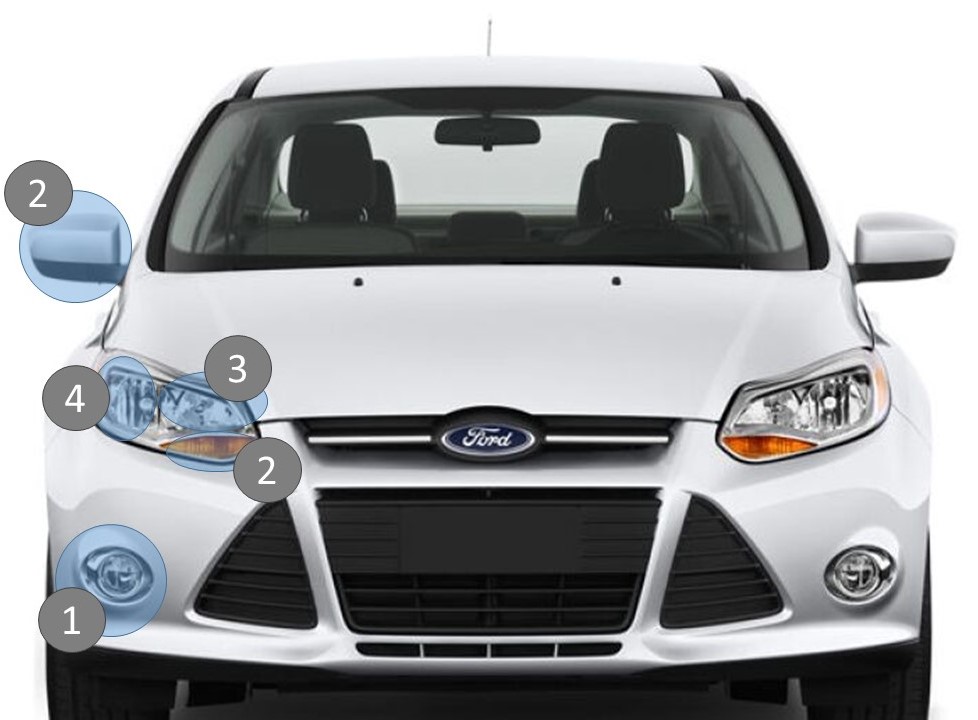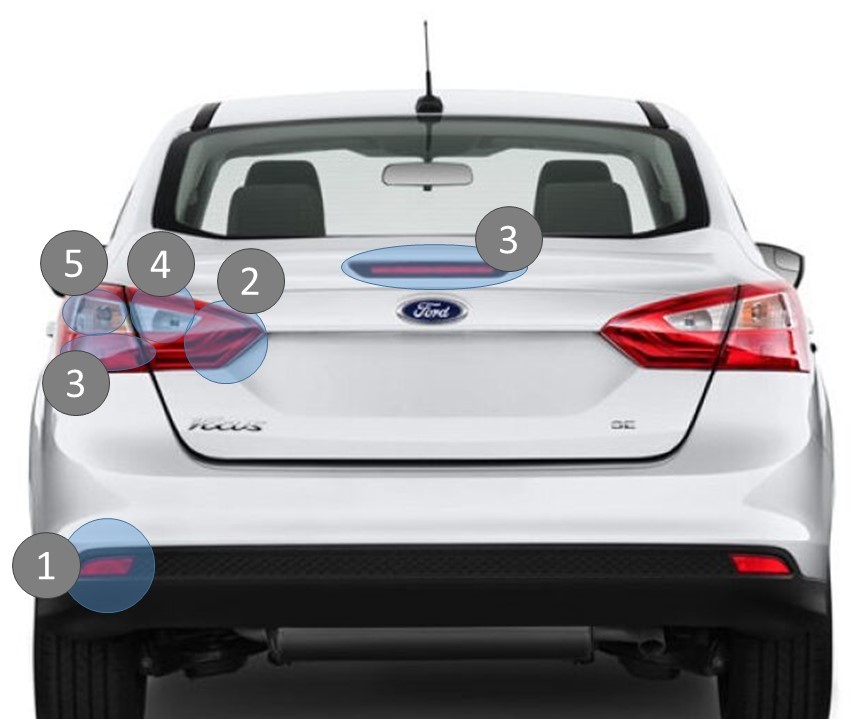Vehicle Lights

- 1: Fog Lights
- 2: Indicators / Hazard warning lights
- 3: Dipped headlights / Daytime running lights
- 4: Full beam headlights
- NA: Auxiliary lights (custom fitted)

- 1: Reflector
- 2: Brake lights
- 3: Rear lights
- 4: Reverse Lights
- 5: Indicator / Hazard warning lights
Full beam headlights
Full beam headlights is the car's most powerful lights. When it's very dark outside (Without other light sources) you must use them as often as possible to increase safety However full-beam headlights are very bright, and can blind other motorist thus the following scenarios should be considered.
Full beam headlights restricted
- When oncoming traffic is so close by that the driver is blinded (This also applies to trains, trailers and vessels).
- When you're stuck behind another car (the driver in the car infornt is dazzled through their rearview mirrors).
- When there is sufficient daylight or street lighting to illuminate the route. (meaning that there are no dark patches on the carriageway or that the road is so well lit that you cannot see better with main beam than with dipped lights)
- You may be blinded by your own vehicle's full beam headlights in the case of fog, severe rain, or snowfall. The water droplets reflect the light back towards you.
Full beam headlights allowed
- You may utilize the full beam headlights as a type of "light horn" to avoid a dangerous scenario in the dark by swiftly flashing them on and off.
- Full beam headlights can be used with any other lights, if you do not risk blinding other motorists.
How to avoid being dazzeled by oncomming cars fullbeam lights
Keep your eye sight fixed on the right side of the road. (Instead of looking straight into the oncomming cars full beam headlights)
Consider the following recommendations and tips, which are not included in the rules
- If you encounter pedestrians on the road you should continue to drive with main beam headlights. It is important that you should see where and how many there are. The risk of daz-zling them is small, since they can look away.
- Even if you are not passing anyone, it may be appropriate to lower your headlights as you approach an intersection. This avoids annoying the cross-traffic at the intersection.
Dipped headlights
While driving at night or poor weather conditions, your headlights must be turned on. Driving with dipped headlights and parking lights on is the most common light combination. It is illegal to use fog lights or daytime running lights in conjunction with dipped headlights.
Combination of dipped headlights
| Light 1 | + | Light 2 | Result |
|---|---|---|---|
| Dipped headlights | + | Fog lights | Not permitted |
| Dipped headlights | + | Daytime lights | Not permitted |
| Dipped headlights | + | Auxiliary high beam | Not permitted |
| Dipped headlights | + | Parking lights | Permitted |
Fog lights
Fog lights are installed in several vehicles.
- During the day, it is permitted to change dipped headlights with fog lights.
- It is also allowed after dark, but only if there is fog, strong rain, or snow.
- It is illegal to use dipped headlights or daytime running lights in conjunction with fog lights.
Combination of fog headlights
| Light 1 | + | Light 2 | Result |
|---|---|---|---|
| Dipped headlights | + | Fog lights | Not permitted |
| Daytime lights | + | Fog lights | Not permitted |
Daytime running lights
Daytime lights may be used instead of dipped headlights in circumstances of adequate daytime visibility. Cars with daytime running lights are uncommon these days. Instead, most of them feature dipped headlights that turn on automatically when the car is started. It is prohibited to use dipped headlights or fog lights in conjunction with daytime running lights.
Combination of daytime headlights
| Light 1 | + | Light 2 | Result |
|---|---|---|---|
| Daytime lights | + | Dipped headlights | Not permitted |
| Daytime lights | + | Fog lights | Not permitted |
Parking lights
You must turn on your parking lights while your vehicle is stopped or parked on the road and the road illumination is insufficient. Even for a brief stop, you must use parking lights. The parking light uses little battery power and can be used for extended period of time
Auxiliary lights
Auxiliary high beam bulbs can be attached to the body of the car to supplement the full beam headlights. There are two types of auxiliary lights
- Cornering lamps: Illuminate the sides / corners of the road closest to the car, allowing you to see beter at night. Usually used on country roads to see animals on the side of the road
- Spot lights: Strong beam focused forward. This allows you to see far ahead
Rear fog lights
The majority of newer vehicles have rear fog lights. This typically implies one or two very powerful red rear lights. The rear fog light's purpose is to make the vehicle visible to oncoming traffic when visibility is poor due to fog, snow, or severe rain. Because the light is bright and dazzling, you must turn it off as soon as you realize that cars behind you have seen you. The instrument panel will illuminates when you turn on the rear fog light.
Brake lights
When you press the brake pedal down, two red lights illuminate at the rear. The brake lights are red and are always brighter than the tail/rear lights.
Tail / Rear lights
Tail / Rear lights are turns on automatically when you turn on the cars lights. There are at least 2 red lights. The brake lights will always be more brighter then the tail lights
Reversing lights
There are usually two white lights which automatically illuminates when the car is placed in reverse. (Select the gear level to "R")
Direction Indicators (Left And Right)
A car has Four indicators. Two on either side (Front and Rear). The indicators are flashing orange lights that must be switched on before turning or moving your car sideways.
Hazard warning lights
All four indicators flash simultaneously. Used during emergency stops or to warn of accident
Rear registration plate lights
One or two lights illuminate the back & front registration plate, increasing its visibility.
